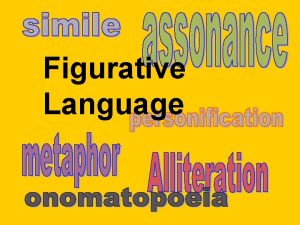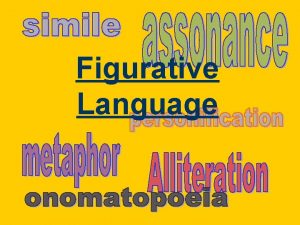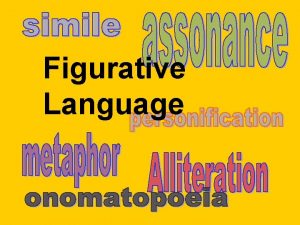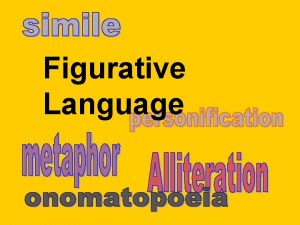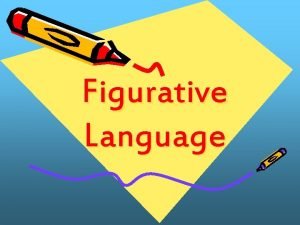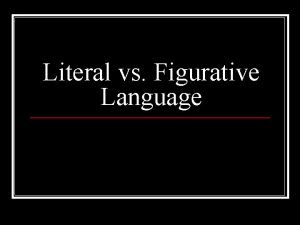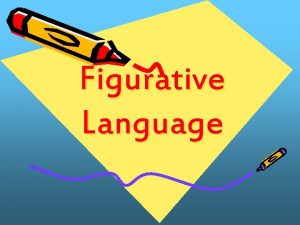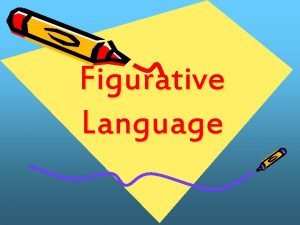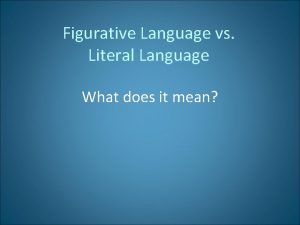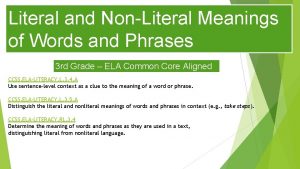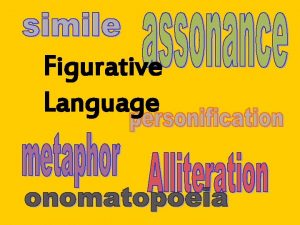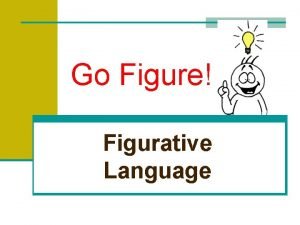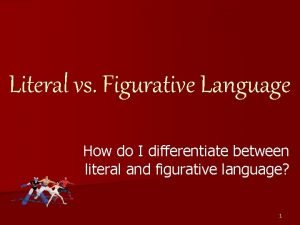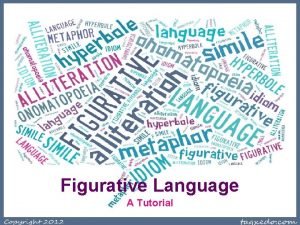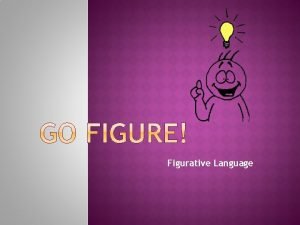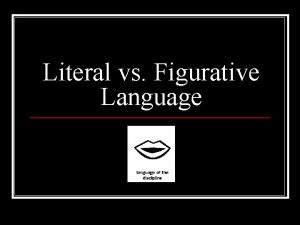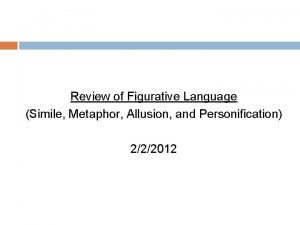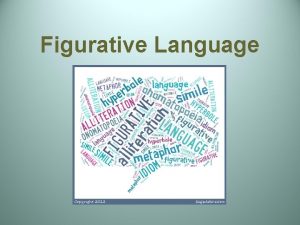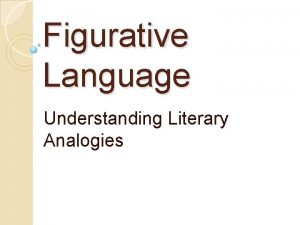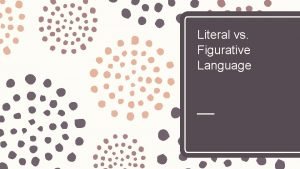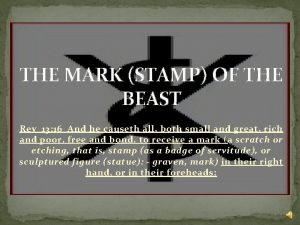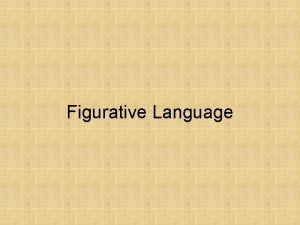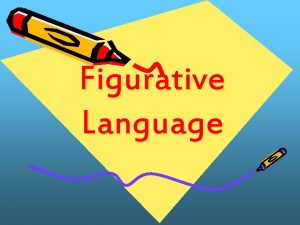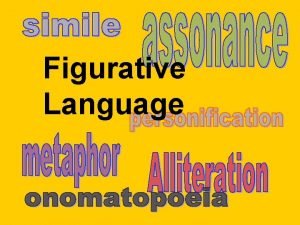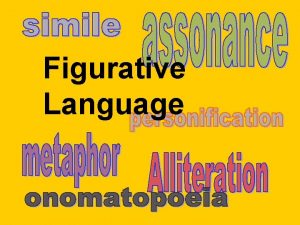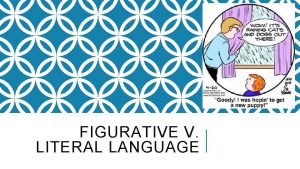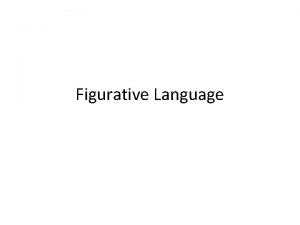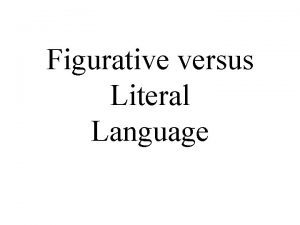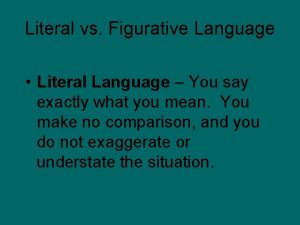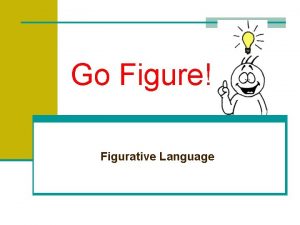Figurative Language Figurative Language The opposite of literal


























- Slides: 26

Figurative Language

Figurative Language The opposite of literal language is figurative language. Figurative language is language that means more than what it says on the surface. • It usually gives us a feeling about its subject. • A writers tool • It helps the reader to visualize (see) what the writer is thinking – It puts a picture in the readers mind

What is figurative language? • Whenever you describe something by comparing it with something else, you are using figurative language.

Types of Figurative Language 1. Simile 2. Metaphor 3. Personification 4. Alliteration/Assonance/Consonance 5. Onomatopoeia 6. Hyperbole 7. Allusion 8. Idioms 9. Imagery

Simile a direct comparison between two unlike things using the words “like” or “as”

I am hungry as a horse. You run like a rabbit. She is happy as a clam. He is sneaky as a snake.


The road was a ribbon wrapped through the desert. The clown was a feather floating away.


The flowers danced in the wind. The friendly gates welcomed us. The hurricane’s winds are yelling while blowing outside my window.


Alliteration (continued) Alliteration: when the first sounds in words repeat. Example Peter Piper picked a pickled pepper. We lurk late. We shoot straight.

Stan the strong surfer saved several swimmers on Saturday. Tiny Tommy Thomson takes toy trucks to Timmy’s on Tuesday. Click here to read more alliterations.


SOUND DEVICE: CONSONANCE - repetition of CONSONANT SOUNDS at the BEGINNING, MIDDLE or END of at least two words in a line of poetry. Examples of Consonance Repeating the “sh” sound in the words: “shush, ” “wish, ” “sharp, ” “cushion” and “quash”

Princess Kitty will kiss Timmy Tippers’s lips The pain may drain Drake, but maybe the weight is fake.


Onomatopoeia: When a word’s pronunciation imitates its sound. Examples Fizz Clink Vroom Buzz Hiss Beep Woof Boom Zip

The firecracker made a loud ka-boom! I knew the car was going to break down because it went chug… The ball went swish as it hit the net.

Hyperbole • An exaggerated statement. It is not used to mislead the reader, but to emphasize a point. Example: She’s said so on several million occasions.

Idioms • An idiom of words or expression different from the ordinary meaning of the words. • The context can help you understand what an idiom means. Example: "She has a bee in her bonnet, " meaning "she is obsessed, " cannot be literally translated into another language word for word.

Idioms (continued) • An expression that carries a different meaning because of the context in which it is used – “slang” terms Examples “Up the creek without a paddle” “On top of the world” “Fingers crossed” “Shake a leg” or “Break a leg” “Put a lid on it” “It’s raining cats and dogs”

Allusion • A reference to a person, event, or place in history or in another well-known work of literature – The writer assumes will recognize the reference Example 1. Someone being as reliable as George Washington or as reliable as Benedict Arnold • Washington was reliable, Arnold was not He’s no Michael Jordan He’s a true Albert Einstein

Irony • When a speaker intends something entirely different than what is said – Say it one way, but “secretly” mean it the opposite way Example Someone accomplishes something hard or is very successful and you say, “You’ve certainly made a mess of things. ” “It smells really good in here!” when referring to something that smells terrible.

What Is an Imagery? Imagery uses words or phrase that appeals to our senses. Images can help us • create a mental picture • hear a sound • feel texture or temperature • taste a sweet, sour, or salty flavor

Teaching Similes and Metaphors • Alliteration Lesson Plan and Resources http: //volweb. utk. edu/Schools/bedford/harrisms/1 allitera. htm • Hyperbole- Lesson Plans and Resources http: //volweb. utk. edu/Schools/bedford/harrisms/10 lesson. htm • Idiom Lesson Plan http: //volweb. utk. edu/Schools/bedford/harrisms/6 lesson. htm • Imagery- Lesson Plans and Resources http: //volweb. utk. edu/Schools/bedford/harrisms/imagery 2. htm • Lesson Plan for Puns http: //volweb. utk. edu/Schools/bedford/harrisms/5 lesson. htm • Onomatopoeia- Lesson Plans and Resources http: //volweb. utk. edu/Schools/bedford/harrisms/9 lesson. htm • Personification Lesson Plans and Resources http: //volweb. utk. edu/Schools/bedford/harrisms/7 lesson. htm • Proverbs- Lesson Plans and Resources http: //volweb. utk. edu/Schools/bedford/harrisms/proverbs 2. htm
 Opposite of literal meaning
Opposite of literal meaning Literal opposite figurative
Literal opposite figurative Opposite of literal
Opposite of literal Opposite of literal language
Opposite of literal language Grant always turns in his homework
Grant always turns in his homework Figurative vs literal
Figurative vs literal Figurative language shampoo
Figurative language shampoo Literal language and figurative language examples
Literal language and figurative language examples What's the difference between an idiom and a hyperbole
What's the difference between an idiom and a hyperbole Opposite of figurative language
Opposite of figurative language Literal and nonliteral meanings
Literal and nonliteral meanings Opposite of figurative language
Opposite of figurative language Opposite of figurative language
Opposite of figurative language Figurative and literal language examples
Figurative and literal language examples Literal vs figurative examples
Literal vs figurative examples Literal language in poetry
Literal language in poetry Masks by shel silverstein figurative language
Masks by shel silverstein figurative language Literal and figurative language examples
Literal and figurative language examples Open oven
Open oven Literal vs. figurative language
Literal vs. figurative language Literal examples
Literal examples Allusion and metaphor
Allusion and metaphor The zebras cried when the wise old elephant died
The zebras cried when the wise old elephant died Figurative and literal examples
Figurative and literal examples Figurative language analogy
Figurative language analogy Literal meaning vs figurative meaning
Literal meaning vs figurative meaning Rev13:16
Rev13:16
